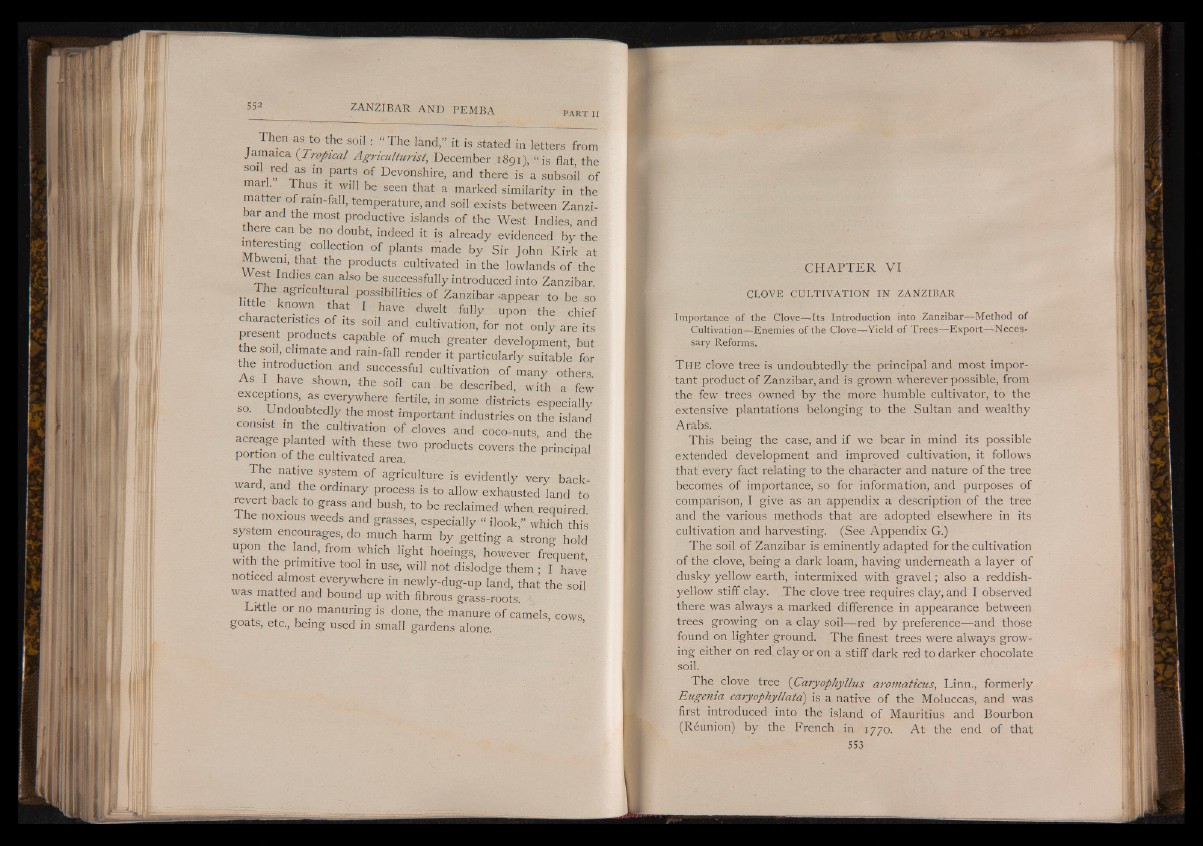
Then as to the soil I “ The land,” it is stated in letters from
Jamaica {Tropical Agriculturist, December 1891), “ is flat, the
, ? d™S in.parts of Devonshire, and there is a subsoil of
marl. Thus it will be seen that a marked similarity in the
matter of rain-fall, temperature, and soil exists between Zanzibar
and the most productive islands of the West Indies, and
. f re Can be no doubt> indeed it is already evidenced by the
interesting collection of plants made by Sir John Kirk at
Mbwern that the products cultivated in the lowlands of the
est Indies can also be successfully introduced into Zanzibar
The agricultural possibilities of Zanzibar-appear to be so
httle known that I have dwelt fully upon the chief
ractenstics of its soil and cultivation, for not only are its
present products capable of much greater development, but
the soil, climate and rain-fall render it particularly suitable for
the introduction and successful cultivation of many others
As I have shown, the soil can be described, with a few
exceptions, as everywhere fertile, in some districts especially
so. Undoubtedly the most important industries on the island
consis in the cultivation of cloves and coco-nuts, and the
acreage planted with these two products covers the principal
portion of the cultivated area.
The native system of agriculture is evidently very backward
and the ordinary process is to allow exhausted land to
revert back to grass and bush, to be reclaimed when required
f noxious weeds and grasses, especially “ ilook,” which this
system encourages, do much harm by getting a strong hold
upon the land, from which light hoeings, however frequent
with the primitive tool in use, will not dislodge them; I have
noticed almost everywhere in newly-dug-up land, that the soil
was matted and bound up with fibrous grass-roots. -
Little or no manuring is done, the manure of camels, cows
goats, etc., being used in small gardens alone.
CH A P T ER VI
CLOVE CULTIVATION IN ZANZIBAR
Importance of the Clove— Its Introduction into Zanzibar— Method of
Cultivation— Enemies of the Clove— Yield of Trees— Export—-Necessary
Reforms,
T h e clove tree is undoubtedly the principal and most important
product of Zanzibar, and is grown wherever possible, from
the few trees owned by the more humble cultivator, to the
extensive plantations belonging to the Sultan and wealthy
Arabs.
This being the case, and if we bear in mind its possible
extended development and improved cultivation, it follows
that every fact relating to the character and nature of the tree
becomes of importance, so for information, and purposes of
comparison, I give as an appendix a description of the tree
and the various methods that are adopted elsewhere in its
cultivation and harvesting. (See Appendix G.)
The soil of Zanzibar is eminently adapted for the cultivation
of the clove, being a dark loam, having underneath a layer of
dusky yellow earth, intermixed with gravel ; also a reddish-
yellow stiff clay. The clove tree requires clay, and I observed
there was always a marked difference in appearance between
trees growing on a clay soil— red by preference— and those
found on lighter ground. The finest trees were always growing
either on red clay or on a stiff dark red to darker chocolate
soil.
The clove tree (Caryophyllus aromaticus, Linn., formerly
Eugenia caryophyllata) is a native of the Moluccas, and was
first introduced into the island of Mauritius and Bourbon
(Réunion) by the French in 1770. A t the end of that
553